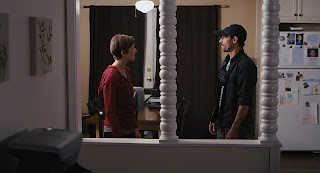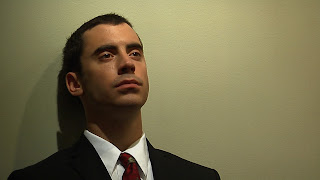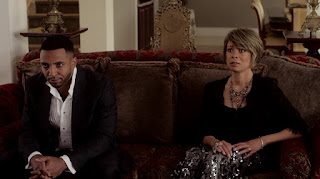DVD Review - Blue is the Warmest Color
This French film by Abdellatif Kechiche premiered at the Cannes Film Festival in 2013 where it won the Palme d'Or. It later went on to be nominated for 8 César Awards, including Best Film. It was also nominated as the Best Foreign Language Film at the Satellite Awards, the Golden Globes and the BAFTA Awards. It won Best Foreign Language Film at the BFCA Awards, the Spirit Awards and the National Society of Film Critics Awards. Due to its late release date, it wasn't eligible for this category at the 86th Academy Awards, but, it's now available under the Criterion Collection.
Based on the graphic novel by Julie Maroh, it's a coming-of-age story about a young girl named Adèle, played by Adèle Exarchopoulos, whose sexual awakening is spurred when she has a passionate, lesbian affair with Emma, played by Léa Seydoux, whose first notable due to her short, blue-colored hair. Kechiche has cut out a lot of the plot from the graphic novel and has changed or shifted the focus. The graphic novel is more about Emma, whereas this film is all about Adèle.
After the film's debut, much talk was centered on the near, 10 minute-long, sex scene, which is very graphic, if not pornographic, between Adèle and Emma. Being that this is a film about sex, I don't think its graphic depiction is out of line. It's certainly not out of line given the fact that a crucial component of their relationship is their sexual chemistry, their attraction and their passion for each other. If the movie is about those things, then depicting those things is not out of line. It should be encouraged. Whether or not it runs too long is debatable.
A true and honest, lesbian love story is rare on the big screen, so some indulgence is allowable. It reminds me of the indulgence that Julián Hernández had in Broken Sky (2006), which was between two young Mexican boys. Kechiche has 39 more minutes here than Hernández, which might allow him more indulgence in all his scenes in general, but while the subject matter warrants it, there is prurience here, but it comes as appreciation of the female form in a way that we don't normally get.
Aside from the lesbian love affair, the second and possibly truer love affair that Kechiche depicts is the love affair the people have here with pasta, particularly spaghetti. Almost every dinner scene in this movie, and there must be a half-dozen or more, is always Adèle and various other people eating tons of spaghetti. It's not like in typical films where actors pretend to eat or don't eat by utilizing dialogue or other actions. No! The actors actually eat here.
It's apparent from the beginning that Kechiche loves his close-ups and that he's mostly going to tell this story with close-ups and mid-shots mainly. There are dozens upon dozens of shots of just Adèle's face, completely filling the frame. With that, there are plenty of those that has Adèle eating spaghetti or sleeping, but mostly eating. By the end, Kechiche makes you intimately familiar with the size and shape of Adèle's lips. Only Adèle's dentist is more focused on her mouth.
Kechiche also makes us aware of other parts of her body, like her ass. With no offense intended, Kechiche wants us to know that this is a girl that has a healthy appetite, along with everyone else, and she is not afraid to show it. More importantly, he's not afraid to show that there are people who are attracted to that. It's not to imply that Adèle is fat or even overweight, but it harkens to the intention of the expression, "real women have curves." There are no body image issues or anything present here that define beautiful women as only those that exist in magazines. What would have made it better if there were women of color in the story, or even more present in the periphery. Women of color, like black women, have traditionally been more curvaceous, so embracing that would have been preferential.
Kechiche is very selective with his wide-shots. He hardly has any. In nearly three hours, only one stands out, the wide-shot of Adèle asleep on a bench. For the majority of the movie, the camera is constantly in people's faces, or it's following Adèle. The sequence that stalks her, as she stalks her way into a lesbian bar for the first time feels so much like how it would feel entering a place like that for the first time.
This film was made just prior to France's passage and legalization of same-sex marriage. Presumably, France is a gay friendly country otherwise, as many European countries are like the Netherlands, Belgium, Spain, Norway, Sweden and Iceland, but it doesn't mean that there is no homophobia. It exists in peer pressure and parental pressure.
Kechiche doesn't hit us over the head with it, but he weaves it into the fabric, such as the anti-austerity protests and the art and the literature discussions that reflect themes. For example, Adèle listens to a teacher who lectures about Antigone and the unavoidability of tragedy, which the relationships of Adèle certainly have.
There is a question of whether Adèle is even fully gay. She might be bisexual. Kechiche continues to have Adèle in flirtations and even direct affairs with men, while she proclaims to love Emma, and it's unclear why, except that Emma might be too mature and more sure of herself, which might intimidate Adèle.
I definitely prefer the ending to Kechiche's film to the ending in Maroh's comic book. It concludes the Adèle and Emma dynamic, and introduces The Adjustment Bureau-style of chance yet purposeful encounters. It's odd that aside from Emma, I never felt like I got to know any of the peripheral lesbians than I did the men who fancy Adèle like Thomas, the senior studying science and who wants his own record label, and Samir, the Arab actor who's been to New York and who has done action films, which I think is weirdly the point as to show Adèle's slow efforts to enter the lesbian social scene.
Even though the film ends with Adèle as an adult and working as a teacher, it shows in the denouement that she's still very much a shy girl in need of learning and growing. As compared to another recent three-hour movie with a central character whose arc isn't that long, if existent at all, Adèle's journey bends a little farther than Jordan Belfort in The Wolf of Wall Street. Whereas Leonardo DiCaprio nails the comedic bits, Seydoux nails the heart-warming, dramatic ones.
Five Stars out of Five.
Rated NC-17 for explicit sexual content.
Running Time: 2 hrs. and 59 mins.
Based on the graphic novel by Julie Maroh, it's a coming-of-age story about a young girl named Adèle, played by Adèle Exarchopoulos, whose sexual awakening is spurred when she has a passionate, lesbian affair with Emma, played by Léa Seydoux, whose first notable due to her short, blue-colored hair. Kechiche has cut out a lot of the plot from the graphic novel and has changed or shifted the focus. The graphic novel is more about Emma, whereas this film is all about Adèle.
After the film's debut, much talk was centered on the near, 10 minute-long, sex scene, which is very graphic, if not pornographic, between Adèle and Emma. Being that this is a film about sex, I don't think its graphic depiction is out of line. It's certainly not out of line given the fact that a crucial component of their relationship is their sexual chemistry, their attraction and their passion for each other. If the movie is about those things, then depicting those things is not out of line. It should be encouraged. Whether or not it runs too long is debatable.
A true and honest, lesbian love story is rare on the big screen, so some indulgence is allowable. It reminds me of the indulgence that Julián Hernández had in Broken Sky (2006), which was between two young Mexican boys. Kechiche has 39 more minutes here than Hernández, which might allow him more indulgence in all his scenes in general, but while the subject matter warrants it, there is prurience here, but it comes as appreciation of the female form in a way that we don't normally get.
Aside from the lesbian love affair, the second and possibly truer love affair that Kechiche depicts is the love affair the people have here with pasta, particularly spaghetti. Almost every dinner scene in this movie, and there must be a half-dozen or more, is always Adèle and various other people eating tons of spaghetti. It's not like in typical films where actors pretend to eat or don't eat by utilizing dialogue or other actions. No! The actors actually eat here.
It's apparent from the beginning that Kechiche loves his close-ups and that he's mostly going to tell this story with close-ups and mid-shots mainly. There are dozens upon dozens of shots of just Adèle's face, completely filling the frame. With that, there are plenty of those that has Adèle eating spaghetti or sleeping, but mostly eating. By the end, Kechiche makes you intimately familiar with the size and shape of Adèle's lips. Only Adèle's dentist is more focused on her mouth.
Kechiche also makes us aware of other parts of her body, like her ass. With no offense intended, Kechiche wants us to know that this is a girl that has a healthy appetite, along with everyone else, and she is not afraid to show it. More importantly, he's not afraid to show that there are people who are attracted to that. It's not to imply that Adèle is fat or even overweight, but it harkens to the intention of the expression, "real women have curves." There are no body image issues or anything present here that define beautiful women as only those that exist in magazines. What would have made it better if there were women of color in the story, or even more present in the periphery. Women of color, like black women, have traditionally been more curvaceous, so embracing that would have been preferential.
Kechiche is very selective with his wide-shots. He hardly has any. In nearly three hours, only one stands out, the wide-shot of Adèle asleep on a bench. For the majority of the movie, the camera is constantly in people's faces, or it's following Adèle. The sequence that stalks her, as she stalks her way into a lesbian bar for the first time feels so much like how it would feel entering a place like that for the first time.
This film was made just prior to France's passage and legalization of same-sex marriage. Presumably, France is a gay friendly country otherwise, as many European countries are like the Netherlands, Belgium, Spain, Norway, Sweden and Iceland, but it doesn't mean that there is no homophobia. It exists in peer pressure and parental pressure.
Kechiche doesn't hit us over the head with it, but he weaves it into the fabric, such as the anti-austerity protests and the art and the literature discussions that reflect themes. For example, Adèle listens to a teacher who lectures about Antigone and the unavoidability of tragedy, which the relationships of Adèle certainly have.
There is a question of whether Adèle is even fully gay. She might be bisexual. Kechiche continues to have Adèle in flirtations and even direct affairs with men, while she proclaims to love Emma, and it's unclear why, except that Emma might be too mature and more sure of herself, which might intimidate Adèle.
I definitely prefer the ending to Kechiche's film to the ending in Maroh's comic book. It concludes the Adèle and Emma dynamic, and introduces The Adjustment Bureau-style of chance yet purposeful encounters. It's odd that aside from Emma, I never felt like I got to know any of the peripheral lesbians than I did the men who fancy Adèle like Thomas, the senior studying science and who wants his own record label, and Samir, the Arab actor who's been to New York and who has done action films, which I think is weirdly the point as to show Adèle's slow efforts to enter the lesbian social scene.
Even though the film ends with Adèle as an adult and working as a teacher, it shows in the denouement that she's still very much a shy girl in need of learning and growing. As compared to another recent three-hour movie with a central character whose arc isn't that long, if existent at all, Adèle's journey bends a little farther than Jordan Belfort in The Wolf of Wall Street. Whereas Leonardo DiCaprio nails the comedic bits, Seydoux nails the heart-warming, dramatic ones.
Five Stars out of Five.
Rated NC-17 for explicit sexual content.
Running Time: 2 hrs. and 59 mins.











Comments
Post a Comment